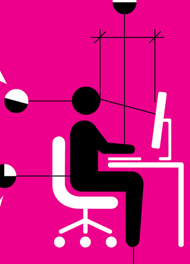So, how can you tell if your office environment is safe and conducive to your comfort and productivity? Consider the following questions:
At the office, do you:
- Sit for long periods of time?
- Perform repetitive arm or hand movements?
- Spend a lot of time on the telephone?
- Have to turn your head to see your computer monitor?
- Take few or no breaks?
- Sit under dim or flickering lights?
- Spend a lot of time looking down at papers on your desk?
- Experience headaches or neck pain?
- Experience aching, numbness, or tingling in your fingers and hands?
- Experience back pain?
If you answered yes to one or more of the above questions, you could be at risk of developing or already suffering from repetitive strain injuries related to your office set-up.
If you are experiencing pain while at the office or after returning home, you are not alone! In a recent survey of office workers who spent an average of five hours each day on the computer, a staggering 70 per cent reported symptoms in their neck, arms, and hands related to the repetitive tasks they performed. Amazingly, 60 per cent of the surveyed workers had information about ergonomics, but fewer than 10 per cent actually implemented it!
Follow these tips below to help make your job easier, safer, and more efficient!
The Keyboard: Position it above your lap. Ensure that you can type with your arms relaxed, close to your body with elbows bent at 90 degrees and wrists level.
The Computer Monitor: Position it directly in front of you. Keep it free of dirt and smudges, in order to reduce glare.
Allow the muscles in your eyes to relax by taking a 20 second break every 20 minutes, during which you look at an object that is located at least 20 feet away from you.
The Mouse: Some workers have a vice-like grip on the mouse. Try using a light grip to avoid strain. When you move it around use your elbow to guide it instead of your wrist.
The Telephone: Use your hand to support the telephone against your ear, and alternate regularly instead of cradling the phone between the ear and shoulder. Consider using a headset or speaker to limit the strain on your neck and arms.
The Chair. Sit upright and all the way back. You can even roll up a towel and place it against the arch of your back for lumbar spine support. Your chair’s height should be adjusted to a level at which your knees are bent at a 90-100 degree angle, with your feet touching the floor.
Spending some time to make simple ergonomic changes to your work environment can improve your comfort and productivity. If you experience any pain or symptoms that may be related to your work, don’t delay in consulting a chiropractor.
Doctors of chiropractic are specialists, who provide drug-free, hands-on treatment that targets the source of pain. Studies show that chiropractic treatment is increasingly recognized as one of the safest and most effective solutions for most patients with back pain.
By
Dr.’s Lily Zayed




